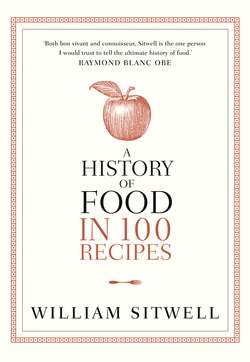Читать книгу A History of Food in 100 Recipes - William Sitwell - Страница 19
Оглавление12
Pasta
1154
AUTHOR: Muhammad al-Idrisi, FROM: Tabula Rogeriana (The Book of Roger)
In Sicily there is a town called Trabia, an enchanting place blessed with water year-round and mills. In this town they make a food from flour in the form of strings. Enough is produced to supply, as well as the towns of Calabria, those in Muslim and Christian regions, too.
Had pasta been knocking around much before 1154? Most likely, yes. There is, for example, an Etruscan relief about forty miles north of Rome at Caere. Painted in the fourth century, it shows what looks very much like pasta-making equipment. But 1154 stands out very clearly as the date when pasta got its first decent write-up. The wording is clear-cut, straightforward, honest and there is no reason to doubt its accuracy.
The reference to it comes from a remarkable book written by one Muhammad al-Idrisi, whose full name was Abu Abd Allah Abdullah, Muhammad ibn Muhammad ibn Ash Sharif al-Idrisi. Born in Morocco in 1099, he started to travel the globe at the age of sixteen, visiting Asia Minor, southern France, Spain and north Africa, which must have felt pretty much like the whole world at the time. He was a poet and writer of Arabic prose whose considerable talent came to the attention of royalty, in the shape of King Roger II of Sicily.
King Roger, who had inherited the throne from his father, also Roger – a conquering Norman adventurer – was a Renaissance man before his time who liked the idea of a court of all the talents. He therefore used his reign and position to surround himself with learned individuals – geographers, mathematicians, philosophers, doctors and the like. So when he heard of al-Idrisi, he invited him to join his gang. Under Roger’s patronage, al-Idrisi proceeded to map and chart the known world from 1138, working on it for fifteen years. So accurate was the map he made that it was used for the ensuing three centuries.
The map, with its accompanying commentaries, goes by the splendid name of The Book of Roger – or Tabula Rogeriana, as it’s more usually known – and is decently subtitled ‘Pleasure Excursion of One Eager to Traverse the World’s Regions’. In matter-of-fact language, al-Idrisi records his knowledge of the land he has both seen and heard about. Some of it sounds mildly derogatory. He describes Britain, for instance, as having ‘dreary weather’. Paris, meanwhile, is a town ‘of mediocre size surrounded by vineyards and forests on an island in the Seine’. But he also makes sensible comments such as ‘the earth is round as a sphere’, not to mention his seminal reference to pasta, which gives rise to plenty of food for thought.
Clearly at the time al-Idrisi was writing, pasta-making was already quite well established. And it was being made in sufficient quantities for export, which suggests it was being stored, but, more importantly, dried. For the key part in the development of pasta is not that the Arabs brought durum wheat to Sicily (around the late seventh century) or that it was later made into strings – not to mention butterflies or little worms – but that it was dried.
That pasta could be dried and stored gives it all the importance of rice as a staple foodstuff. And although there are mentions of what sound like pasta in references to ancient Greece and Arabia, the Italians, quite understandably, claim it as their own.
Anyone wishing to counter their claim should visit the National Pasta Museum in Rome – just opposite the Travi Fountain. It is, the museum states, ‘the Italian invention that the world envies’, adding how its ‘eleven exhibition halls disclose eight centuries of the history of the first course’ (just in case any ignorant foreigner should think it was a main-course dish). Sicily was fortuitous as a starting place for pasta as it was well placed to trade internationally and it had a stunning effect on civilisation. As Mary Snodgrass writes in her Encyclopedia of Kitchen History:
Pasta was a momentous addition to world civilization for several reasons. It stored well, thus allowing the warehousing of foodstuffs against famine and fueling monetary speculation during peacetime and war based on predictions of price and demand. More important to the global economy, the formation of hardtack and pasta from durum wheat permitted galley kitchens to feed ships’ crews over long ocean journeys of the type that introduced Europe to the Western Hemisphere.’
Thus Italy took pasta to its heart. The great Roger II must have eaten it, no doubt to help sustain that vast intellect. ‘The extent of his learning cannot be described,’ al-Idrisi said of his patron, while one contemporary historian wrote how ‘he accomplished more asleep than other sovereigns did awake’. The Book of Roger was published in 1154 and Roger II died three weeks later. The flag of pasta had been planted on the soil of Sicily – and Italians have been thanking him ever since.
The Art Archive: Marc Charmet
Drawn by al-Idrisi for Roger II of Sicily in 1154–1157 and included in the Tabula Rogeriana, this map shows Italy, Sicily and the Mediterranean Sea.
